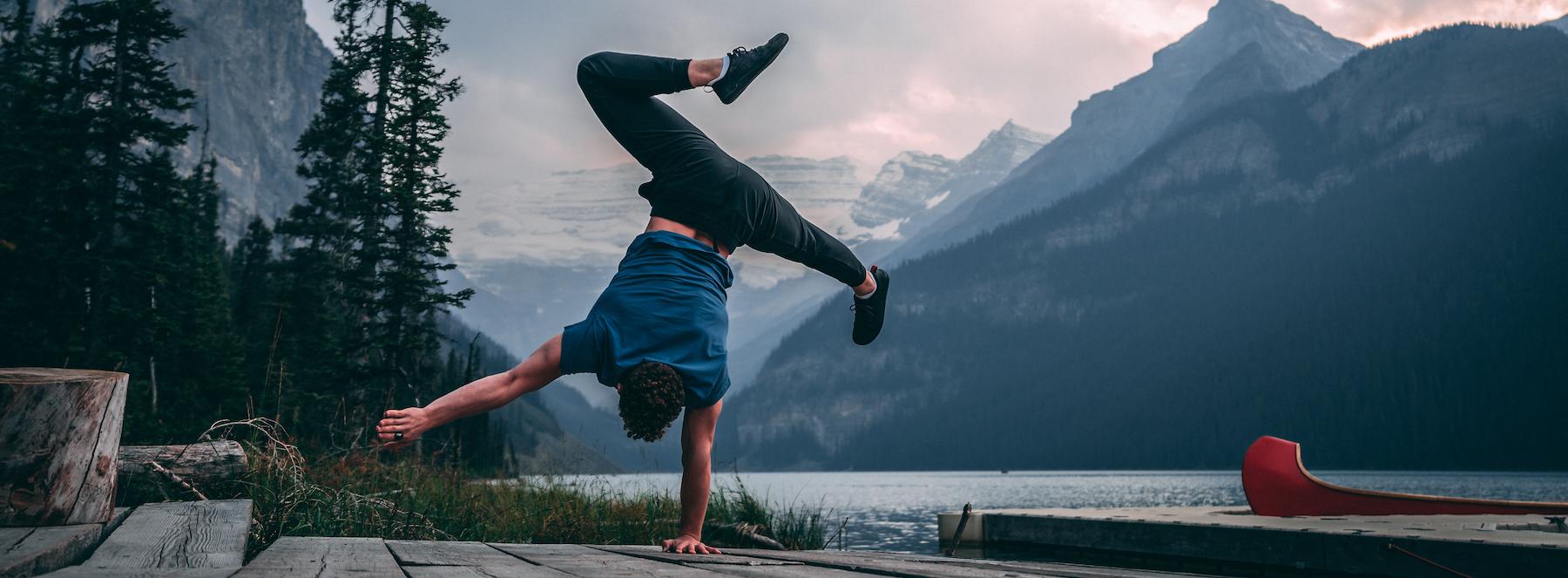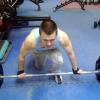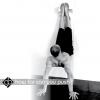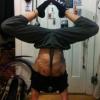Search the Community
Showing results for tags 'rehab'.
-
Hi, I’m 9 weeks post shoulder surgery (full thickness tear of the supraspinatus and bicep tendons). Still working with a physiotherapist and my mobility is improving, it still has some way to go before I can start training again. I’m keen on getting back into the program, but not sure where to start. I own most of the level 1 programs, but think that may be too much until I have my full range of motion restored. Where is the best place to start and improve my shoulder mobility or strength? I haven’t yet subscribed as my plan was to complete the level 1 programs before joining the subscription program. As such, I don’t have access to the Restore series and wanted to know if perhaps they too would be too advanced for this stage of my rehab. I don’t want to start a free trial only to find it wasted at this stage. Alternately, is there is better program than the “Restore” series to work back into, starting with my shoulder rehab? Thanks for any advice. Wayne
-
Hi all I'm reaching you guys asking for an advise for my shoulder and bicep injuries My training routine was bodyweight, Rings and some parallettes I also used Gymnasticbodies stretching series I injured my self I'm not sure how but probably was over training using the RINGS The MRI results is FINDINGS The right supraspinatus tendon demonstrates bright signal that is seen reaching the tendon articular surface but not its bursal surface. Right acromioclavicular joint arthropathy is noticed. Type II acromion. Intermediate signal seen involving the subscapularis and intra-articular long head of biceps tendons. Normal MRI appearance of the glenoid labrum, gleno-humeral ligaments and joint capsule. Subacromial subdeltoid bursal fluid distension is noted. Normal appearance of the articular cartilage of the shoulder joint. IMPRESSION Right supraspinatus tendon partial thickness tear. Right acromioclavicular joint arthropathy. Subacromial subdeltoid bursitis. Intra-articular long head of biceps and subscapularis tendinopathy. Doctor advised to take a rest and stop excersicing specially overhead exercises As I read that loading and exercising is better than resting for recovery Phisyo sessions here in Saudi Arabia are very expensive and most of it just Ice and laser therapy without any excersices What's your advice Should I rest or do any of GB programs or series And how long will it take to heal from your experience Thank you
-
Hello! I am requesting a bit of help. About a month and a half ago, I started having wrist and elbow pain after doing bar muscle ups. I believe it stemmed from using too much momentum and a lack of wrist mobility. For example, I can't even bring my wrists to a 90 degree angle (I'm almost there but not quite) without using an external object such as a wall. So far, I've rested my arms for a month while using ice and occasionally heat. For about three weeks now I've been using heat only. I've also been doing eccentric wrist curls for about two weeks with very low weight. I do not feel random pain anymore. The only time I feel pain or discomfort is occasionally when driving, lifting or carrying objects, and sometimes when drawing (I'm an artist). It occurs on the insides of my elbows. This pain, out of 10, is probably a 2 or 3. I would more so call it a brief discomfort at this point. Do you all believe that I can begin using Handstand One to rehab/strengthen my wrists and elbows? If not yet, when can I use Handstand One to start strengthening my wrists? Would it be beneficial to begin Foundations One? If you have any advice pertaining to my questions, please help me out! I also welcome any advice that you can offer that does not deal with F1 or H1. Thank you!
-
Good evening ladies and gentlemen, oh, and beasts, there should be some in here, judging from the coach's work. XD I'm new to this forum. Coach Somer directed me here after contacting him online to adress my problem so that everybody could benefit from whatever needs to be said about my condition. I guess that injuries in this part of the body may not be as popular as shoulder-elbow ones, yet I believe it needs to be addressed as it attacks athletes of any status, be it proffessionals or amateurs, gymnasts or gym rats, vertical leap freaks or desk-syndrome junkies! What am I talking about? The dreaded JUMPER'S KNEE. Getting started on the condition I feel like I need to post a brief summary of who I am and what i do, so that you may better understand my goals, and then get on the more general side of things... First of all, I am a Greek basketball athlete. My goal is becoming a proffessional in the sport. For the moment, my knees are thwarted by tendinosis in the patellar tendon, to be exact the lower pole of the patella. It has kept me one year and something TOTALLY OUT of my sport. I used to be quite the athlete when it came to basketball (see, I'm talking like a grandpa, but i'm only 20!) Had about a 2xsquat and deadlift when i was 18, could jump about 92cms with running approach, could dunk it while being 5.8ft tall etc etc. The problem came due to overworking, extrinsic factors such as concrete courts and my inability to give it a f*king rest when my body told me for two goddamn years to stop (through pain) Well, enough with the bragging, down to the problem. One knee (left, my primary jumping knee as a right handed basketball player) is severe enough to have warranted a prior (failed) surgery done arthroscopically (debridement) The other is just your regular run-in-the-mill jumper's knee. The severe condition presents fibrotic tissue in about 1/3 of the tendon's width coupled with the usual tendon thickness, and some other menial sites of fibrotic tissue under recovery due to the (stupid) doctor's choices to debride tissue that should have been left alone. There is evidence of a previous partial tear of minimal importance (as it has healed now) yet scar tissue remains present there (at the insertion) too. It has all the characteristics of insertional patellar tendinosis plus some. NOW: My plan of action is using a recently popularized method called Tenex to debride the faulty tissue, a couple of prp+ Stem Cell injections and a peptide (called tb500) to warrant quality healing, aka no more fibrosis and re-injury. The less injured knee will recieve about the same treatment except for the Tenex procedure, which is out of my league (cost-wise) for both knees, which will be interchanged for percutaneous needling to make the injury acute again and warrant a new healing cycle. Lengthy introductions have been made. Now, the three REAL questions i got. 1.Has ANYBODY here used the Tenex procedure, Stem Cells, Peptides (yes, I know they are considered and technically are anabolics, thank you) to get ANY tendon rid of fibrosis, aka curing tendinosis in ANY site, not necessarily the knee? Do you know about somebody who did? 2.Has anybody gotten rid of severe Patellar Tendinosis-Jumper's knee by any OTHER means? 3.(probably most important) What can I do with a damaged knee except terminal leg raises and isometric holdings to keep excercising to avoid further atrophy of my quad-bicep femoris? Also, what will I do to condition my knees AFTERWARDS to turn them into IRON SPRINGS? Is there any gymnastics protocol? I'm aware there is one discipline in gymnastics where they jump doing flips and so from one corner to another (don't know how they call it in English, sorry) and they seem to have really conditioned legs... Thanks to everybody willing to read all this and respond, and sorry for the lengthy post. All questions, answers and general contributions are welcome, thanks to coach Sommer for giving me access to this forum
- 30 replies
-
- KneeTendinosis
- Pain
- (and 6 more)
-
Hey guys ive posted before regarding my current elbow concerns (in both elbows) and have taken advice from you by getting X Ray's seeking specialists etc . I went to see my local physiotherapist who advertised in joint issues and sports injuries so thought I would receive the advice / diagnosis /treatment I was after. however upon my first visit and subsequently my second visit yesterday she started using acupuncture. I have no knowledge on this subject so thought I would ask your advice . To me this seems like some kind of alternative treatment that has no real scientific substance to it . Am I wasting my time (and money)with this kind of treatment. I've felt no difference at all in how my elbows feel after both sessions and have to say was somewhat surprised that this was even used by a physio therapist as I assumed I would only get this kind of treatment if I specifically went to an accupunture clinic. is this common place now a days? She has also taped them up with kt and again what good this is doing I've no idea. My our advice would be much appreciated as always Many thanks Leigh
- 15 replies
-
- acupuncture
- kinesio
- (and 4 more)
-
Hello, I'm a newbie here on GB. I just bought F1, H1, and Stretch courses yesterday, hoping to start my fitness journey anew. Long story short, I injured (pulled) my right hamstrings about 13 months ago from doing 5RM Barbell Back Squat in StrongLift 5x5 program. Despite finding help from PT who led me through series of isometric/eccentric rehab exercises told me to lower my squat volume, I continued to squat heavy and sustained my injury for the next 4 months. I also got hip impingement from the same side as well although it is now much better. The hamstring strain, however, never really got better over the years. The pain was right where sitz bone (ischial tuberosity) and hamstrings meet, so it is extremely likely that it's tendon inflammation issue. ;( The thing is I want to start F1, H1, and stretch courses right away, but I'm so worried that my hamstrings issue may flare up again. I regularly do yoga for over a year, and every time I try any forward fold or front/side splits, my hammie would cry for mercy. How should I proceed with the GB Programs I bought? What are some caveats if I delve into specific causes, regarding my chronic injury? Thank you, NT
- 9 replies
-
- injury
- hamstrings
-
(and 1 more)
Tagged with:
-
Hello everyone I'm new to gymnastics and find it very interesting! I currently own a Martial arts school and train Muay Thai and Jiujitsu 4-5 times a week and was wondering if this Is a good compliment along with having 2 bi lateral hip surgeies I need strengthing snd stretching for sure ! Most recent was one year ago
-

Any success making a full recovery from high hamstring tendon tear?
Paul Clay posted a topic in Mobility
Hi All, I'm at about month 20 of recovering from a high hamstring tendon injury. It's been a sllloooowww process. Fortunately, after months of plateaued recovery progress (or even regression), I discovered that *stretching* was the source of my lack of progress. I've stopped stretching my hamstrings completely. I'm as stiff as I've ever been but my hamstring is finally healing. Though I'm still only probably at 90% recovery. I'm nervous about how to return to developing hamstring mobility. Does anyone else have experience with returning to stretching a hamstring after an injury? Is there a protocol for returning to stretching? Because most therapists only deal with getting patients back normal ROM, I can't find any materials on what, say, a gymnast would do to return to competition after a hamstring tendon injury (or any tendon/muscle involved in extended ROMs). Thanks! -

Are you better than my doctor? - Elbow (Ulnar Nerve) Injury for 7 months
TheQuest posted a topic in Mobility
Hey there, Ive been having elbow problems since late January 2014. The trigger of my problem was probably(!) a combination of those two exercises: -Swedish Bars Front Support ( https://www.youtube.com/watch?v=uvuWwMcwRXM ) -Swedish Bars Back Support ( https://www.youtube.com/watch?v=KDCr_lXDd64&list=UUPCiBMarvDiTx-lknzt934g ) I combined them into following interval sequence: D1. Swedish Bars Front Support 10-30 sec D2. Swedish Bars Back Support 10-30 sec -Repeat D1, D2 for a total of 5 sets, resting 45-90 sec between exercises *I found this whole sequence on Ido Portal's blog and youtube account. However, i had basically no experience before in straight arm strength or support exercises ( maybe done L-sits some times before, however nothing structured). Means, my elbows weren't prepared at all for this stress, and of course, it resulted in injury. Around the same time, i messed around with tucked front lever and back lever tucks,-probably progressed too quick here too- that may have contributed to the paint injury symptoms I've been having since then. However, i did a heck lot of unstructured strength training, skill work , played more tennis than usual at that time, so it could also be some "collective injury/pain trigger". Basically: I was totally retarded. When Im looking back, Im thinking like " wtf did you do to your body?- injury out of what you did was a certainty". This was in late January 2014. So , please don't tell me this was dumb. Much rather, Id appreciate any input what you would do in my situation. What I did so far: Since then, Ive been to 2 doctors, and 3 physios.- Yet, nothing great has changed. 1 doctor and 1 physio was shit, ( diagnosis of them: tendonitis or bursitis, advice: rest and it will go away. also: never extend your elbows fully!! - "yes for sure, i thought",- and went. The other sports orthopedist and physio ( and osteopath ) both diagnosed me ( independently of each other) with some kind of ulnar irritation.- this made perfect sense, as my pain was in that funny bone- area, and when i accidentally would bump my elbow against something- it would hurt as well. So: DIAGNOSIS: Some kind of Ulnar Nerve Irritation. However, its very local and ISN’T radiating down the arm, and also ISN’T initiating some tingling sensations in my pinky. The sports orthopedist also found out ( via x-ray and visual inspection) that my elbows are having some slight valgus deformity- means their angles isn't around 180 degrees, but more about 168 degrees. Hence- he said- i ve been predisposed to those problems,and this external stress triggered my injury. He prescribed me physiotherapy for strengthening and stabilizing the elbow joint as well as ultrasonic therapy and cryotherapy. Im doing ultrasonic 2 x a week, each arm 10 min. , right after it cryotherapy 1 min. i think, also both elbows. Then, last week, my phyio added a new thing to this Diagnosis: He said he thinks my ulnar nerve isn’t really lying inside the cubital tunnel properly, it is more like slid up ( the medial epycondile i guess). Hence, increased friction ( because of that improper alignment) to my ulnar nerve could be the reason why my elbow still is doing trouble to me. ( Considering i stopped doing all sports since i found out this could be something severe ( around the beginning of March 2014, maybe even earlier). Supplements: Im also taking the following supplements (as advised my 2 good(!) physios:) Vitamin B complexVitamin Dliquid fish oil, 2 teaspoons a dayExercises: Those exercises have been prescribed to me recently: side-lying external rotation with 1kg dumbbell ( 3 x ~20, daily) Sitting/Standing External Rotation with 2 kg in each hand (3x ~20, daily). ( heres a photo of this so we both talk about the same: http://www.beginnertriathlete.com/cms/articleimages/884/External-Rotation-Standing2.jpg So im doing those exercises daily, and also go to the physio about 2 times a week, where he does some manual manipulation. He said my ulnar nerve isn’t really in its "cubital tunnel" and IF its in,it always tends to hop out again , so he tries to bring it back in its groove permanently via some nerve mobility manipulation. The given exercises should reinforce so much stability to it, so it will hold the nerve stable. Also he tries to get some tension out of the adjacent muscles, also out of the neck, the lats and the upper arm. ( Since the nerve is going all the way down from the neck to the pinky). Thats about what was told to me. So this is about my treatment plan, but im not very sure if it will really give me the kind of relief i was hoping for. Until now, it didn't. If you'd had any input, Id be very glad. Thank you!- 8 replies
-
- Nerve
- Ulnar Nerve
-
(and 8 more)
Tagged with:
-
After trying out a variation of the pelican exercise I experienced some discomfort both inside my elbow and on the outside, (mostly on the inside). I have stopped working on this exercise and I will not go for it for a very long time. The question is then; should I take a break from training entirely or should I continue working on these exercises: Rings turned out support holds 20-60s German Hang 20-40s Front lever and back lever when the discomfort disappear Are there other exercises i should do to prepare/rehabilitate my elbow tendon?
-

Snapping triceps/ subluxation of ulnar nerve during pushups
nostalgiaforinfinity posted a topic in Mobility
Hi i have snapping triceps/ subluxation of the ulnar nerve during pushups when my hands are pronated and i descend into the bottom of a pushup. When my elbows flare out its bad. I have been putting my hands at 10 and 2 which seems to release some of the tension on the nerve but not completely. Would fully supinated hands make a difference? Its an odd tingling sensation not pain more like somebody hits your funny bone. As a warmup before my routine i do l-sits, handstands, the novel elbow series, and ido portals scapular mobilization band routine. I started doing a few ulnar nerve glides but i haven't seen much progress and I'm absolutely not interested in surgery. Any personal experience with improving this annoying situation is helpful.-
- Ulnar nerve
- snapping triceps
- (and 7 more)
-

Is the F1 course even suitable for me? (with all of my problems....)
Jonas Hohmann posted a topic in Getting Started
Is F1 even suitable for me? Hey there, I have a few concerns and questions regarding the GB online courses ( Foundation 1, first and foremost, as this is the starters-course). 1. Structural Integrity - Is variablility possible? Ive been having several issues or injuries with my body, that has to be continously be treated via exercises(Strengthening of stabilizing muscles, as well as the weakened musclew and specific stretching) that improve my structural integrity. Namely, the ones that i think would be affected most by exercises that arent tailored to my conditions would be shoulder issues( that are only coming when my push-pull ratio is out of order: i generally have to pull more than i push to remain healthy. ( and of course i have to do mobility as well as strengthening the shoulder-stabilzing muscles, like e rotator cuff e.g.). That appears to me is coming from my predisposition that my pec muscles are ( mostly determined by looks ) /appear larger than my back muscles, hence i have slightly winged scapula as well as slighty forward pushed shoulders. Quote of coach sommer: "Posted 13 February 2014 - 11:45 PM While some do indeed insist on such a ratio, GB does not. Yours in Fitness, Coach Sommer " Since this ratio ( of more pulling)! isnt used here, im worried that ill develop shoulder issues on the way. So: is it possible to adjust the program to the point that im more pulling? Im also wondering on the WAY: The program is tailored to the common guy that has the common postural prepositions: slouched shoulders/ kyphosis and anterior pelvic tilt/ weak glutes/ weak hamstrings, tight quads. How then is this program then fixing those imbalances. Heavy pike-stretching seems to be involved, more pushing than pulling etc.Im not trying to "hate" here, im just trying to understand how this program works. There might be some clues i dont get yet.... Maybe this program fixes those problems just in a different way i dont understand? If you do, please help me out! Returning to my personal issue: After all: To me, this program looks very fixed...or are there was given to address personal imbalances? The second problem im facing is the one with my patella tendinosis. Treatment that im following involves strengthening of the glutes, stretching of the anterior hip, quads etc. - basically fixing muscular imbalances that are caused by the sedentary lives nowadays. So basically: stretching the muscles that overtighten in modern sedentary lifestyle, and strengthening the "posterior muscular chain". And I dont see that f1 would do that for me: pike stretch for the manna: stretching the already weak hamstrings, Single Leg squat progressions without being coupled by posterior chain work ( for the lower body). This gives me the question: while this program may be great for people without any injuries or imbalances, im asking myself: is it even suitable for me? And if not: is it allowed/ does it make sense to chance it to my needs? Or would it then rather make much more sense to do a whole another program, suited towards my issues? As said:. I am worried that this program will help me with those progressions, but will worsen my knee condition by imterfering in the structural integrity of my lower limbs here. Also, another question: How would that extreme hamstring flexibility (build up in manna progr.) be influencing overall sportivity and danger of injury in track and field sports? I am, in school, in an intensive sport course, where we are doing some of the popular sports, also im a tennis player. I heard that extreme hamstring flexibility increases injury risk in such sports because of increased instability in those sports.. Also, several PTs tolr me that i am hypermobile and should stop stretching so much.i should focus more on stability work to stabilize respective joints. I hope youre seeing my dilemma... Looking forward to your input! Yours, Jonas -
Hi everyone, Sometimes shit happens. I unfortunately fractured my metacarpal of the index on my left hand almost 2 weeks ago. It's now plastered up and I have no choice but to be patient. I was of course exceedingly frustrated at first but am now grateful it's "only" a small fracture on one hand. Could of landed on my head I guess..! Anyhow it's now more often leg day and I'm alternating between SLS variations and some weighted lunges and squats. For my GB Foundation training I'm just taking it as an opportunity to revisit and emphasize the basics; HBRs, ABRs, V-Ups, Side Planks, etc.. and of course a ton of mobility work! As to Handstand practice I'm back to elbow headstand and presses. Any training ideas? Anyone been through this kind of injury? Any tips on speeding up recovery? Tips for rehab' when the time comes for me to be plaster-free? And how to progressively reintroduce handstand work and stress on my hand? PS. Being injured right now completely relieves the impatience of delayed M1 release hahaha Have a great day! Mark
-
I posted this in another thread but the issues on that thread were already resolved and it seemed like I was starting a new thread within a thread, so I just decided to post it as a new topic again instead. Whenever I used to do exercises that involved hyperextension of the back, my "Lower/side" back would cramp up. The thing is though, my erector spinae wasn't what was cramping. The way I figured it out was doing Iliopsoas stretches directly after, which soothed the low back pain but not the deep dull side pain, which remained for days on end. Did a bit of research and figured that it had to be my Quadratus Lumborum, a muscle for which I haven't yet found a stretch that could be performed without a partner and that actually targets this muscle. Even foam rolling or using a tennis ball fails at successfully reaching this region. As a way to deal with this issue, I try to always perform exercises with a "stacked" spine or at the bare minimum to be mindful of my coccyx being "tucked", which reduces pulling tension on my Iliopsoas and to some degree on my QL. 1)Are there holds/exercises where the back shouldn't be tucked? (in martial arts, tennis, swimming, and many other sports they teach you that being stacked is how you control your body as one single unit) 2)Is the QL involved in hyperextending the back? or in anterior pelvic tilt? 3)Are there any good solo QL stretching exercises out there? 4) Say you have tight hip flexors, hamstrings or any muscle you want. It's tight and you can also feel a pain that resulted from this tightness. Do you recommend stretching?(I assume yes) BUT do you recommend strengthening: -after the pain has gone away? -while there's pain, but to train the muscle within the confines of what one would consider tolerable pain/not debilitating pain? -what if you haven't been strengthening the muscle, but kept stretching it correctly for a number of months and there is an increased range of motion and flexibility but still some residual pain. Could this be because of a lack of training this muscle? Should you start strengthening it? I would really appreciate Kitlaughlin's input on this(as well as anyone else that wants to shed some light on this issue)
- 2 replies
-
- back pain
- stretching
-
(and 7 more)
Tagged with:
-
There are a lot of topics on biceps tendon rehab/prehab but the triceps stuff are more scattered. I am confused so could anybody point me in the right direction? It would help everybody if we could sum up all those information in one topic. Also, spefically about what happens to me: It's a mild pain on the back of the elbow, towards the inside(between the arm and the ribcage). It only hurts when I am doing a wall handstand (I don't do any extreme stuff, just F1-PE1s). Is it a Tennis Elbow? Because its in the inside part of the back elbow.
-
Hello. Yesterday I walked 30 km / 19 miles on asphalt. Barefoot. A total of 6 hours and 15 minutes. Today I have some sharp pains here and there in my feet. I'm not afraid since I know what caused it, and I know they will disappear if I just rest my feet. (And the feet will come back stronger too!) The sharpest pains are in the bigtoe extensor tendons, and the abductor tendons of the feet. (Runs along outer edge of footsole.) Just some observations. Aside from this, no pain. (Except the blisters). The question is: Will prolonged, warm footbaths speed up recovery? Another question: Will prolonged, warm baths with the entire calves dipped into help prevent shin splints? I don't have them at the moment, but I'm training my legs to be resilient for running and don't need calf injuries. Thanks.
- 5 replies
-
- tendonitisbarefoot
- shin splints
-
(and 2 more)
Tagged with:
-
Hi! Today my shoulder dislocated during training for the second time since starting F1. My routine is as laid out in the book. 4-5 days a week. I'm on Pe1 on most movements. The first time was this Thursday (less then three days ago) which I also followed up with 20 minutes of handstand and 40 minutes of weightlifting focusing on the shoulder area. The focus if the weightlifting is to a some mass to my shoulders, especially the back and around the scapulae to improve my posture and add some cushioning to rolls on hard ground (Parkour). After I was done, stretching and all, I thought I´d be a good boy and do some wall stretches (back flat against wall, arms perpendicular to the floor, 90 degree bend in the elbows, back of hands against wall and move hands up and down.) I barely placed my elbows on the wall and rotated my arms up against the wall before my shoulder popped with some crunching sounds in the shoulder socket. It popped back after a few seconds. The second time was today, Sunday. Again my F1/Pe1 workout done. Followed it up with some rehab exercises from Dieselcrew (search on youtube of interested) Cuban rotations 2x 12-15 Band external rotation 2x 12-15 Band pullapart 2x 12-15 Band pulldown behind neck 2 x 12-15 Band dislocations 2 x 12-15 After that I started practising handstands. After one 30 sec hold I dropped back. Felt good. Rested a minute or so, and just stretched my hands down out my sides, feeling a little tight in chest. POP! There went my shoulder for a trip once again! This is SO FRUSTRATING! Especially since I'm actually doing rehab-exercises reguarly! I have a history of shoulder dislocations, I've probably had over 30 incidents during the last 12 years. Thats why my shoulder can pop back again after a few second, but believe me, these are full luxations. Since december 2012 I´ve been really good at doing my oh so boring rehab exercises, and above all, I´ve started implementing Bent-over side laterals with 2-5 kg dumbells for 15-20 repetitions for 2-4 sets every weightlifting session and my shoulders have felt amazingly stable! I've been dislocationfree since august 2012. Before starting training with gymnastics. I like gymnastic training, I love handstand training. But obviously this programming doesn´t cut it for my unstable right-shoulder. I need advice on what to do. I believe that my chest and front of my body is much stronger than my rear delts and scapulae muscle and therefore, need a different kind of ratio of pressing (SpL, HbP) to pulling (RC) exercises. Also, any advice on how to implement handstand practise? Now I'm doing face to wall-handstands.
-
Having some sholder pain during pull-up motion, so cut those out for now. My right tricep and various parts of the inner arm has lots of knots and trigger points so am going to work that out first. The shoulder pain could be referred from this. All other motion is fine. What do you guys think of this approach for rehab and general shoulder strengthening?







